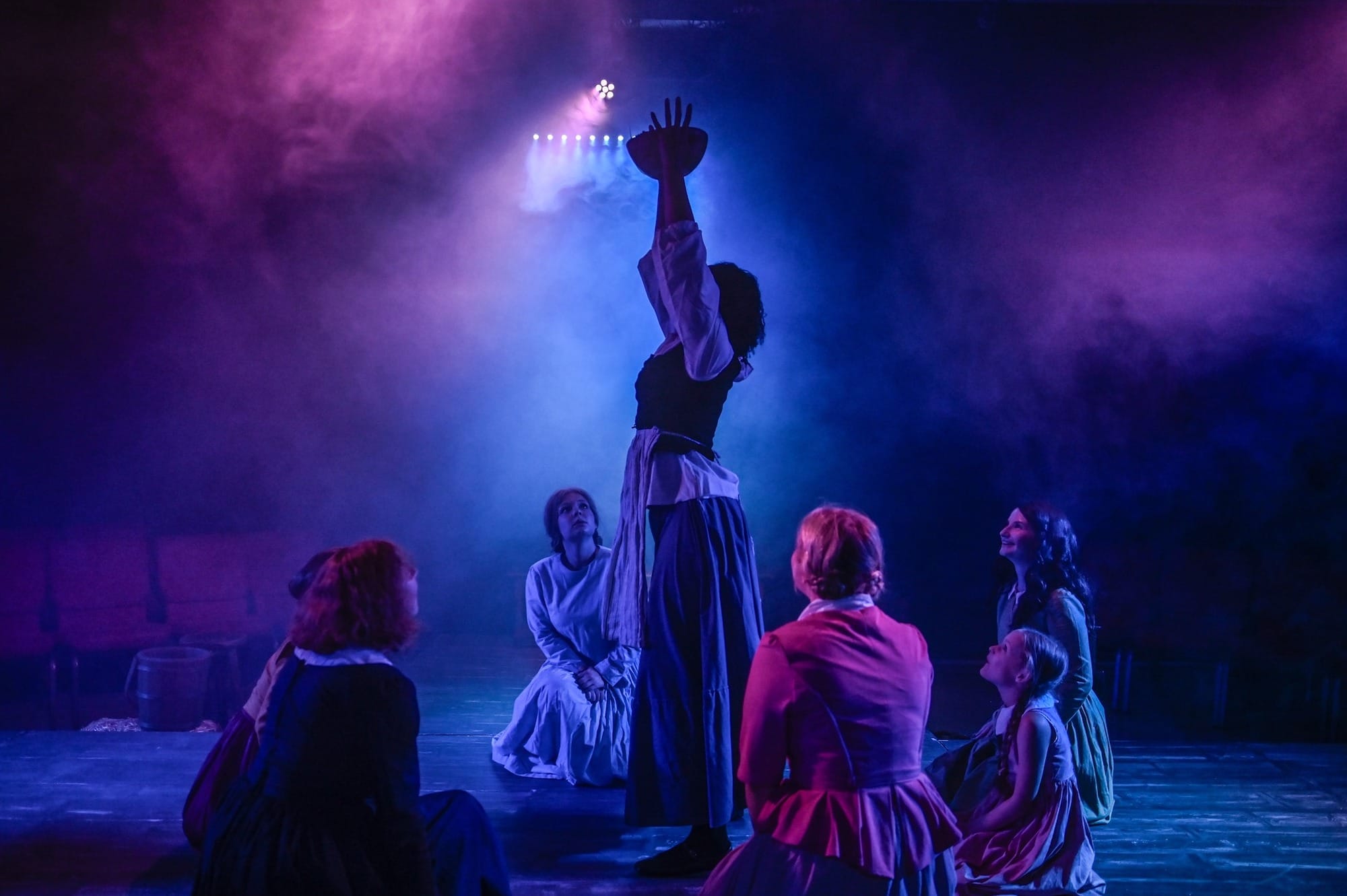Theatre Tulsa: The Crucible
Theatre Tulsa Studios
August 17, 2025
I saw The Crucible for the first time when I was 11, at what would become my future high school. I went with my grandma, who taught math there and liked to support her students. From the moment in Act One when Tituba entered the stage and began performing her ritual for the girls, I was hooked; I’d never felt that much fear in my life watching a live production. My grandma, on the other hand, fell asleep. I feel like this is the biggest challenge when staging Arthur Miller’s infamous play, one that Theatre Tulsa faces in its current production (up through August 24): It’s easy for the plot to come across as procedural until the truly tense moments.
No matter how tricky it might be, staging The Crucible now makes sense. With a well-received adaptation (John Proctor is the Villain by Kimberly Belflower) about to end its Broadway run, a big comeback for witches lately in popular culture, and an ongoing spot in the high school literary canon, it’s an easy sell. It’s also a timely one, just as it was in 1953 when it premiered as an allegorical commentary on McCarthyism.
For those of us who did not read the play in high school, The Crucible is a partially fictional account of the Salem Witch Trials. The story follows inhabitants of Salem, Massachusetts in 1692 after 17-year-old Abigail Williams and her friends falsely accuse women of being witches. But Abigail has a motive. After having an affair with farmer John Proctor, she has it out for his wife, Elizabeth, in hopes getting rid of her will allow her and John to be together.
While the text’s main plotline is quite salacious, the play largely examines morality’s tie to integrity and the way guilt can manifest if one partakes in deception. Miller incorporates these themes into every character’s story, politically and socially, whether that’s about who actually owns a plot of trees or what one’s true “thrifty business” is in Barbados. Because of that, every character has a clear motivation and reason for being exactly where they are. When done well, it’s fascinating to see how their stories intertwine.
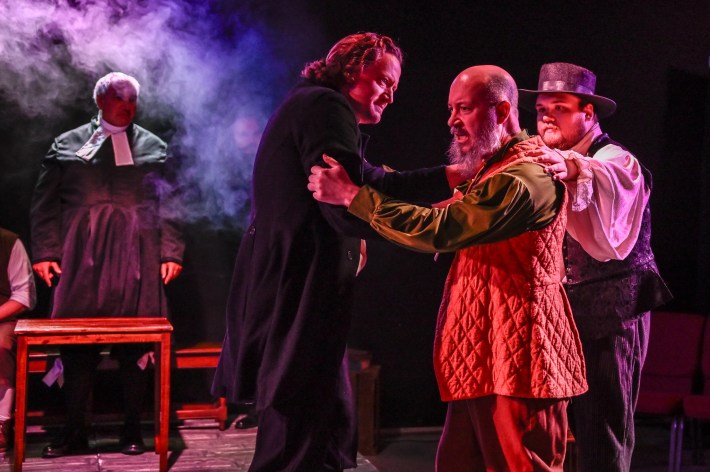
In Theatre Tulsa’s production—which marks the directorial debut for Mandy Gross and Lisa Hunter—many actors find humanity in Miller’s somewhat antiquated dialogue. Don Amon is delightfully haughty as Judge Danforth, while Sarah Schudt’s doe-eyed, anxious Mary Warren (one of the accusers) is sympathetic. Sebastian Paden’s earnest and grounded Reverend John Hale is a perfect foil to Ben Morgan’s pompous and flittering Reverend Parris. Jasmine C. Perry is engrossing as Tituba; her playfulness is captivating and her fear is raw. And I have to mention Michael Reed, a young actor who stepped in at the last minute to play 70-year-old Francis Nurse and looked so convincingly frail that I thought he was going to fall over.
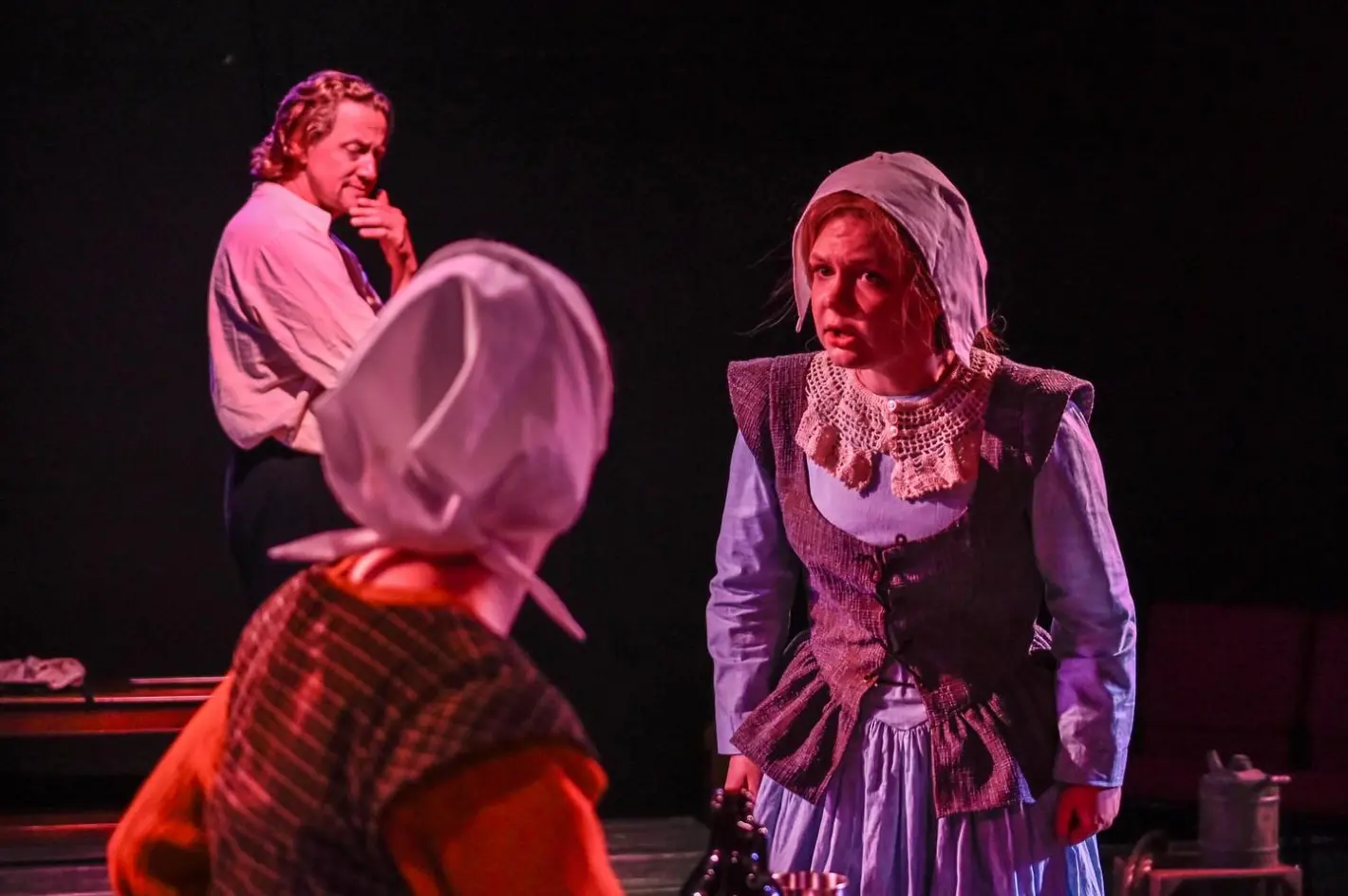
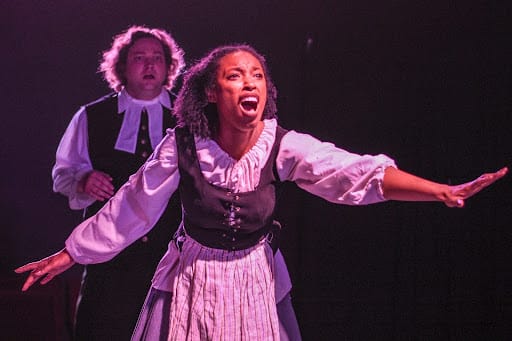
L: Fletcher Gross (John Proctor), Meagan Mulgrew (Elizabeth) and Sarah Schudt (Mary Warren). R: Ben Morgan as Reverend Parris and Jasmine C. Perry as Tituba | photos by C. Andrew Nichols
The most gripping moments involve Fletcher Gross as John Proctor, Meagan Mulgrew as Proctor’s wife Elizabeth, and Prudence Lloyd as Abigail, especially in scenes following Proctor’s infidelity and its impact on the two women. Whenever Gross and Lloyd were alone on stage, I felt like I should leave the room, so strong was their chemistry. Gross and Mulgrew have a different energy: while their characters appropriately start the show completely disconnected, their last moment together, at the climax of the drama, finds them totally, physically in sync.
These local actors are working at the top of their game. Lloyd enlivens every scene as Abigail, effortlessly switching from meek to bratty to seductive within minutes to create a delightfully duplicitous character.
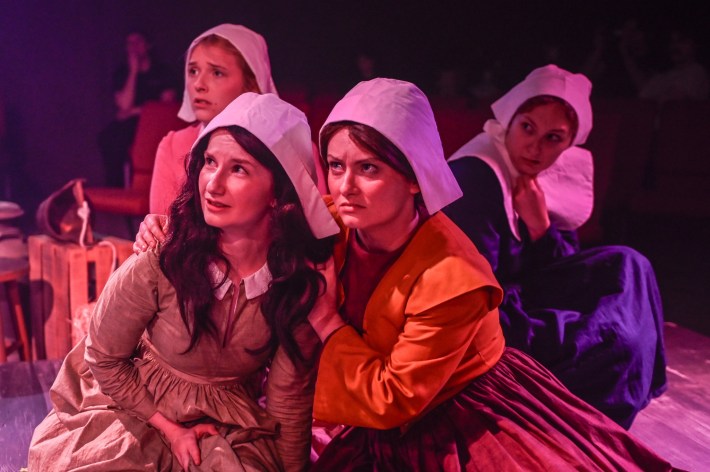
Gross begins the show as a grounded leading man who you find yourself getting behind, until you remember he cheated on his wife with a teenager. It’s a treat to watch him unravel as Proctor’s guilt grows. Mulgrew adds a bite to Elizabeth with a remarkably intentional performance in which not a single line is thrown away and every word feels layered. Her physical and emotional crash is visceral: a devastating reminder of the grim reality of the Witch Trials.

On a technical level, Theatre Tulsa continues to challenge itself in its former Dollar General studio space. Chris Porcelli’s striking lighting design transported the audience to the woods at night and to the courtroom. Philip Jaques compiled an eerie sound design with woodland wildlife and Gregorian chants that set the tone even before the play began and elevated the spookier moments. The simple rustic set gave a consistent sense of place, with movable wooden benches, stools and a table serving as furniture as needed.
Gross and Hunter’s decision to direct the play in the round—with the audience seated on all sides of a stage shaped like a cross—helps the plot move, but blocking has to be precise and open for an orientation like this to work. For much of this production, I felt like I was missing crucial parts of the performance. I saw a lot of backs during the show. I couldn’t see a good chunk of Scene One because two characters were standing in front of me. Some actors regularly performed monologues and key moments with feet planted, delivering their lines to only one side of the stage. Others were completely locked in with one another, standing close together and looking directly at each other, which heightened the energy and made for good chemistry but left much of the audience out of the story. A stage shape with so many angles only really works if the audience sits above it. When seated in the second row on the floor, you can’t really make it out enough for it to have an impact.
For a story about an event that affected primarily women, I forgot how much of Miller’s play consists of men speaking. It’s true to the time, as men were the ones in power, serving in the court and church. Even with the power that Abigail and her friends assume with their fake ability to “spot witches,” the script focuses on how men (and, to be fair, Elizabeth) responded to the mass hysteria. Gross and Hunter made an effort to compensate for this imbalance by choreographing some scene transitions that allowed us to see more moments featuring the women: the young girls sneaking around and giggling as older women were carried off to jail, and a heartbreaking arc that centers Martha Corey, played by Kathleen Hope. I enjoyed those moments and loved seeing talented ensemble members more, but they didn’t necessarily deepen my understanding of Salem or Miller’s dense text, nor always help the pacing of the play.
Some moments in the play’s second half—the part of the script that deals with Salem’s court system, and that made my grandma fall asleep—lag. Several issues outside the main plot come to a head: a man tries to save his wife from her witchcraft sentencing, a farmer confronts a land owner about an ownership dispute, the court tries to use John Proctor to convince a woman to confess to witchcraft (thus saving her life), and the audience sees the faulty rationale that guides the court’s rulings. But compared to the central drama of the play, these moments feel flat. Directing the actors’ performances to highlight the themes of deception and fear here could have helped the dynamics of mass hysteria and the script’s parallel to McCarthyism come through more strongly.
Quibbles aside, I love seeing Theatre Tulsa continue to take some artistic risk with the studio series. Gross and Hunter’s vision for The Crucible makes for a rather bewitching piece of theatre.
